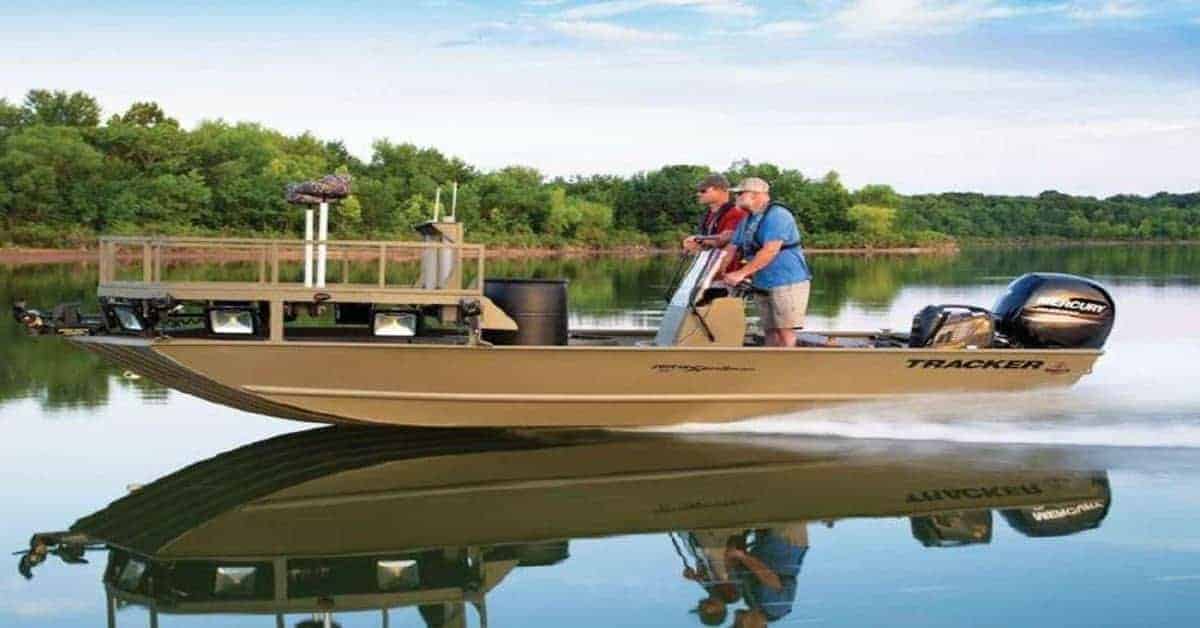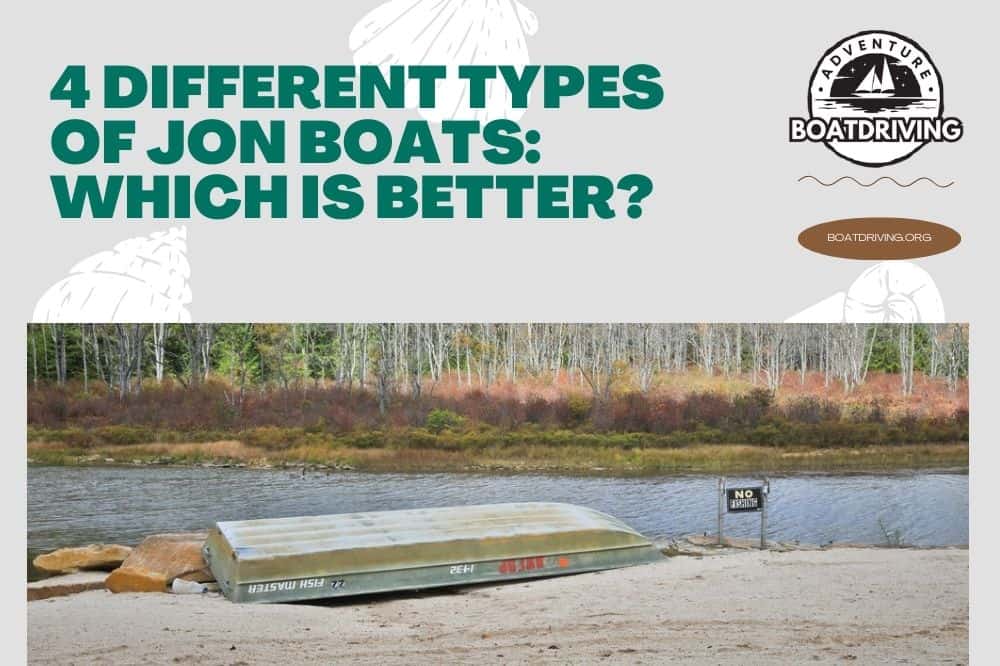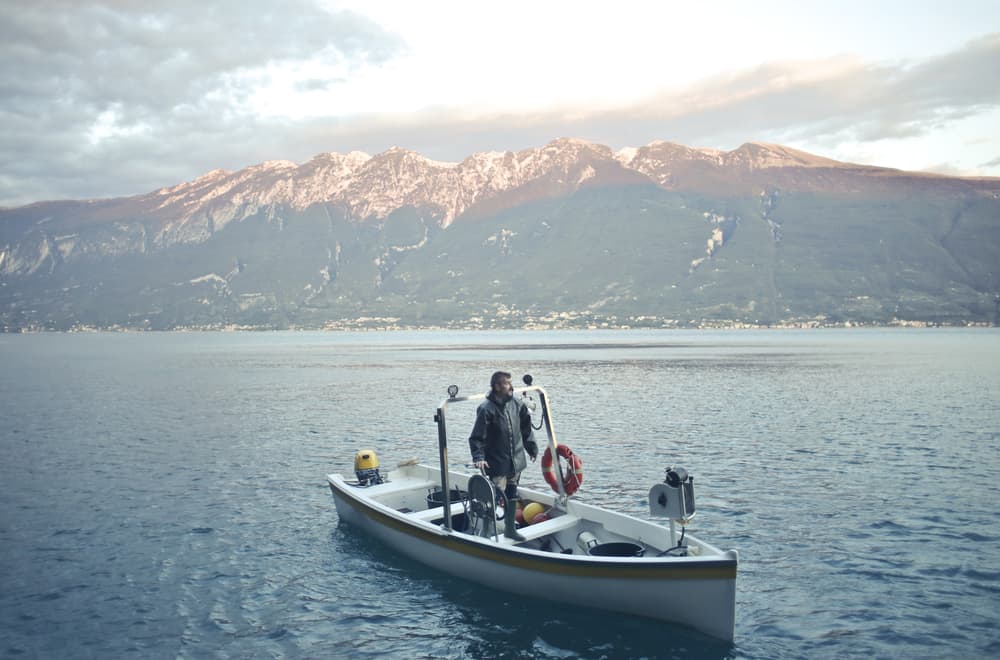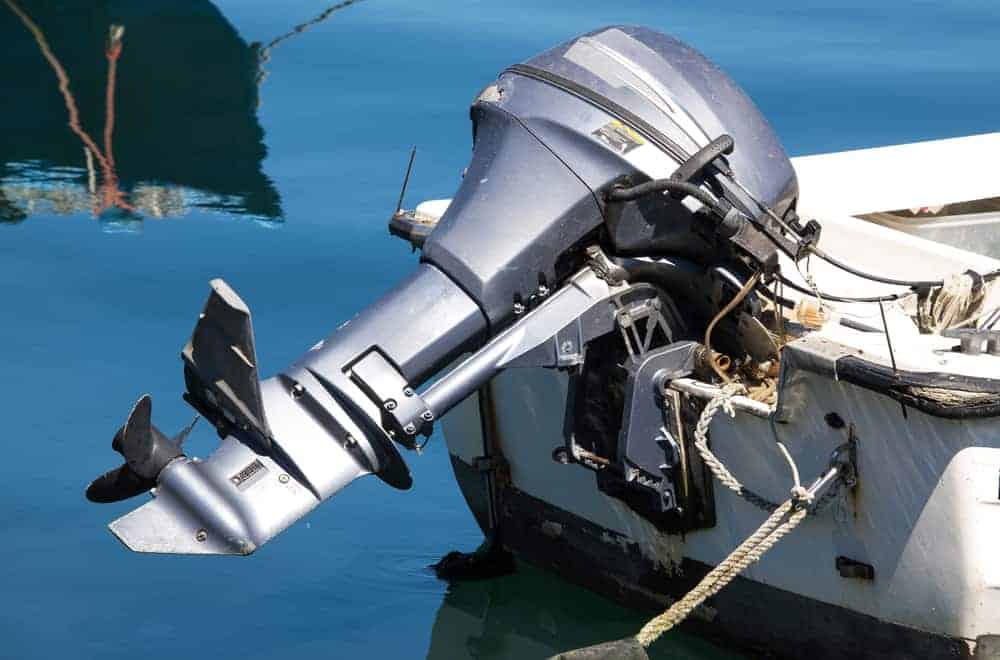Jon boats come in two types- the classic flat-bottom hull and the modified V-hull designed for performance. So without further ado, let’s jump aboard and discuss the design, advantages, and environments for these boats that are notorious amongst anglers, utility workers, and leisure seekers alike.
Table of Contents
What Are Jon Boats?
Jon boats are low-profile boats with a shallow draft-excellent for navigating through shallower waters. Boating enthusiasts of all types trust Jon boats in lakes, rivers, and other coastal waterways.
Though some manufacturers include a performance-designed Jon boat in their lineup to handle choppier water, this type of boat is not one to take out for offshore excursions.
To point out a Jon-boat, look for an almost always aluminum low-profile boat with an entirely squared-off bow. They will be noticeably unfamiliar compared to the v-shape or curved fronts you may be more used to seeing.
Materials Used To Fabricate Jon Boats
Usually, two things will affect your decision on the preferred material for your Jon boat. That said, your fabrication options include:
- wood
- aluminum
- fiberglass
- wood wrapped in fiberglass
The earliest boats utilized locally sourced wood to fabricate their vessels, and that tradition remained true for the beginning of the Jon boat. However, manufacturers found new materials that could offer significantly better performance and efficiency over time.
Wood is a heavy material, and although nostalgic to the sailing enthusiast, truth be told, it is difficult to care for and maintain. That said, wood is readily available and an accessible material to work with for someone who would enjoy building their own Jon boat.
For additional sealant protection and overall durability, one could even decide to wrap their wooden boat with multiple layers of fiberglass. You will want to be careful if fiberglassing over an older boat because the last thing you want to do is trap in moisture. For new builds, you do not have this concern.
The other alternative for Jon boats is to fabricate it entirely out of fiberglass. Fiberglass is a durable and lightweight material that is waterproof, easy to mold, and relatively straightforward to repair.
The last material most commonly seen on modern Jon boats is aluminum. With a background in aviation, I have spent over ten years fabricating, maintaining, and repairing critical flight surfaces using both aluminum and fiberglass.
The fact is that aluminum weighs lighter, costs less, and an aluminum boat will be much easier to launch, load, and trailer.
Even though aluminum is susceptible to corrosion when subdued to saline conditions, this won’t be a significant concern for your Jon boat. However, you can remove this concern by sticking to freshwater lakes and rivers.
In a nutshell, Eric Matechak, avid angler and outdoorsman, confidently states, “aluminum is the most popular material and quite frankly the best of the three options.”
Design Of Jon Boats
The flat bottom Jon boat is the most popular type- no question. Its hull design not only gives you access to hard-to-navigate waterways but gives you the advantage of stability and versatility.
These boats are regularly used by birdwatchers, nature explorers, hunters, anglers, utility workers, and families just wanting the spend a day together on the water.
Although Jon boats perform exceptionally well in low and calm waters, expect one uncomfortable ride when faced with choppy waters. The flat-hull does not handle choppy water and big splashing waves well, so please stay safe and respect your boat’s limitations.
If you love the Jon boat concept but would like to explore the waters further away from the coast and plan on encountering more challenging seas, then the modified V-hull is right for you.
The modified V-hull has much better maneuverability and stability in choppy waters, though you may notice it not being as steady in calm waters as the standard flat bottom.
In designing a more performance-based hull, manufacturers gave the mod-V a sharper bow to cut through oncoming waves and a more angular hull bottom- though this provides this version with a deeper draft which you should consider when approaching shallow waters.
Jon Boat Sizes
Market sales indicate that most people purchase a Jon boat between ten and eighteen feet in length. However, some outdoor depots may manufacture a Jon boat as small as eight feet long, while the longest on the market currently is the twenty-six-footer by SeaArk Boats.
If you are having trouble deciding on the appropriate size Jon boat to purchase, I invite you to consider the following things:
- How do you intend to use your Jon boat (specific activity)?
- What type of waters will you be primarily navigating?
Smaller boats may be great for smaller waterways; however, their size may not handle more challenging waters. On the flip side, a larger Jon boat can take on more of the elements; however, it sacrifices maneuverability in tight spaces and will require a significantly larger motor (more money, more problems).
Best Jon Boat Manufacturers
Jon Boat Prices

Remember that its size selected accessories will determine the overall cost of your Jon boat, and options, in addition to the most suitable motor.
The smallest Jon boats could get away with nothing more than a trolling motor; however, if you plan on having a bigger boat, then financially plan for a bigger engine.
So what are the numbers? First off, I’d like to mention that in any case, Jon boats are generally more affordable when compared to other fishing, hunting, and recreational vessels.
Now, you can get crazy with it if you want and completely deck out your Jon boat with every technological gadget and accessory available to assist you in your game- but that price tag will start to get hefty.
The open design of Jon boats is ripe for various storage configurations and personalization based on your intended use. Keep it basic or turn your Jon boat into a mean-and-lean business machine- the choice is all yours.
On any of the manufacturers listed earlier, you will notice they have integrated an intuitive boat builder application on their website, which gives you the ability to explore additional options and features you like the most with associated costs.
As you can see, it is rather challenging to provide you with an exact figure for your budget; however, you could step out onto a smaller Jon boat with a brand new 2.5 HP motor for a combined price of under $2,000.
Jon Boat Motors
To find the most compatible motor for your Jon boat, please consider the following:
- What are the water conditions that you primarily navigate?
- What is the intended purpose of your boat?
- Will you be carrying passengers?
- How much equipment and gear do you plan to tow along (overall weight calculations are critical to your boat’s capacity).
- Do you prefer a particular hull configuration over another (flat bottom or deep-V)?
- What’s the difference in associated storage, towing, and operation costs of a bigger vs. smaller boat (and engine)?
Narrow down your engine search to outboard motors. The hull design of the flat-bottom or mod-V Jon boat eliminates the possibility of an inboard or sterndrive engine (you should thank the boat gods for this one).
One significant advantage of outboard motors is controlling the power and direction of your boat by moving the entire engine. You can operate an outboard engine using a tiller- a handle that attaches to the rudder.
Alternatively, you can have a Jon boat outfitted with a side or center console for those who prefer a driving experience similar to automobiles. Though this may sound nice, you have to weigh the pros and cons of a more complicated drive system and less deck space.
If you prefer this option, I recommend hiring a marine mechanic to ensure a professional installation of your retrofitted steering system.
Typical Jon Boat Setups: Size to Power Ratios
Again, if you only plan to circumnavigate a small pond with, let’s say, an eight-foot Jon boat, you will be more than happy with sticking to a trolling motor- these are electric, quiet, and environmentally safe.
Now you could still get away with a trolling motor if you upgrade to a ten-foot Jon boat; however, this will also likely depend on water conditions and overall capacity.
For anything larger, you will require a motor that is better capable of moving you and your Jon boat around. If you would like to stick to electromobility, I recommend looking at how Torqeedo is leading the industry.
But if you can’t pull yourself away from traditional fuel-driven propulsion systems, may I suggest Mercury Marine. This superior company maintains excellent ratings in terms of low-emissions and environmentally-conscious manufacturing.
So let me offer you just a couple of hypothetical builds:
- Option A: 16-foot flat-bottom Jon boat
Typically, you can carry up to 1,000 pounds in weight and require a 30-35 horsepower motor. You can safely cruise up to 30 miles per hour with this power pack.
- Option B: 18-foot mod-V Jon boat
With the ability to carry approximately 1,200 pounds in weight, you can outfit your boat with a motor with a prescribed max output of up to 90 HP. Of course, you will be cruising at high speeds with a larger engine, but a 60 HP motor will be just fine.
Last Minute Considerations
As your boat size increases, you open yourself up to more seating arrangements, storage capacity, and additional features for your intended use.
Many enthusiasts utilize Jon boats for entertainment and hosting lakeside birthday parties for the kids with a stable enough hull to jump out into the water.
Conclusion
Flat-bottom and mod-V Jon boats are efficient, affordable, and versatile. If you are ready to move along with your purchase, please consider all the variable factors discussed in this article.
If you have any further questions or concerns, please leave them in the comment section below.

Joseph Fabiano is a writer, nature enthusiast, and stay-at-home father of two wild and free boys. He enjoys starting his day with a good run, hot mug of coffee, and a jump in the Ionian Sea, no matter the weather. Currently based in the Apuglia region of southern Italy, he enjoys discovering the world with his best traveling buddies (his little monkey’s and beautiful wife) at every given opportunity. Every trip, long or far, should be made an adventure according to Joseph as he believes inspiration and creation is right in front of you.





